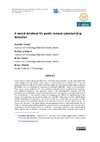Please use this identifier to cite or link to this item:
https://accedacris.ulpgc.es/handle/10553/70375
| DC Field | Value | Language |
|---|---|---|
| dc.contributor.author | Power, Aurelia | en_US |
| dc.contributor.author | Keane, Anthony | en_US |
| dc.contributor.author | Nolan, Brian | en_US |
| dc.contributor.author | O'Neill, Brian | en_US |
| dc.date.accessioned | 2020-02-19T17:21:09Z | - |
| dc.date.available | 2020-02-19T17:21:09Z | - |
| dc.date.issued | 2017 | en_US |
| dc.identifier.issn | 1133-1127 | en_US |
| dc.identifier.uri | https://accedacris.ulpgc.es/handle/10553/70375 | - |
| dc.description.abstract | Public textual cyberbullying has become one of the most prevalent issues associated with online safety of young people, particularly on social networks. To address this issue, we argue that the boundaries of what constitutes public textual cyberbullying needs to be first identified and a corresponding linguistically motivated definition needs to be advanced. Thus, we propose a definition of public textual cyberbullying that contains three necessary and sufficient elements: the personal marker, the dysphemistic element and the cyberbullying link between the previous two elements. Subsequently, we argue that one of the cornerstones in the overall process of mitigating the effects of cyberbullying is the design of a cyberbullying lexical database that specifies what linguistic and cyberbullying specific information is relevant to the detection process. In this vein, we propose a novel cyberbullying lexical database based on the definition of public textual cyberbullying. The overall architecture of our cyberbullying lexical database is determined semantically, and, in order to facilitate cyberbullying detection, the lexical entry encapsulates two new semantic dimensions that are derived from our definition: cyberbullying function and cyberbullying referential domain. In addition, the lexical entry encapsulates other semantic and syntactic information, such as sense and syntactic category, information that, not only aids the process of detection, but also allows us to expand the cyberbullying database using WordNet (Miller, 1993). | en_US |
| dc.language | eng | en_US |
| dc.relation.ispartof | LFE. Revista de Lenguas para Fines Específicos | en_US |
| dc.source | LFE. Revista de lenguas para fines específicos [eISSN 2340-8561], v. 23 (2), p. 157-186 | en_US |
| dc.subject | 570107 Lengua y literatura | en_US |
| dc.subject | 550510 Filología | en_US |
| dc.subject.other | Cyberbullying | en_US |
| dc.subject.other | Lexical database | en_US |
| dc.subject.other | Linguistic analysis | en_US |
| dc.subject.other | Natural language processing | en_US |
| dc.title | A lexical database for public textual cyberbullying detection | en_US |
| dc.type | info:eu-repo/semantics/article | en_US |
| dc.type | Article | en_US |
| dc.identifier.doi | 10.20420/rlfe.2017.177 | en_US |
| dc.investigacion | Artes y Humanidades | en_US |
| dc.type2 | Artículo | en_US |
| dc.identifier.ulpgc | Sí | es |
| dc.description.esci | ESCI | |
| dc.description.dialnetimpact | 0,0 | |
| dc.description.dialnetq | Q3 | |
| dc.description.dialnetd | D6 | |
| dc.description.erihplus | ERIH PLUS | |
| item.grantfulltext | open | - |
| item.fulltext | Con texto completo | - |
| Appears in Collections: | Artículos | |
Items in accedaCRIS are protected by copyright, with all rights reserved, unless otherwise indicated.
